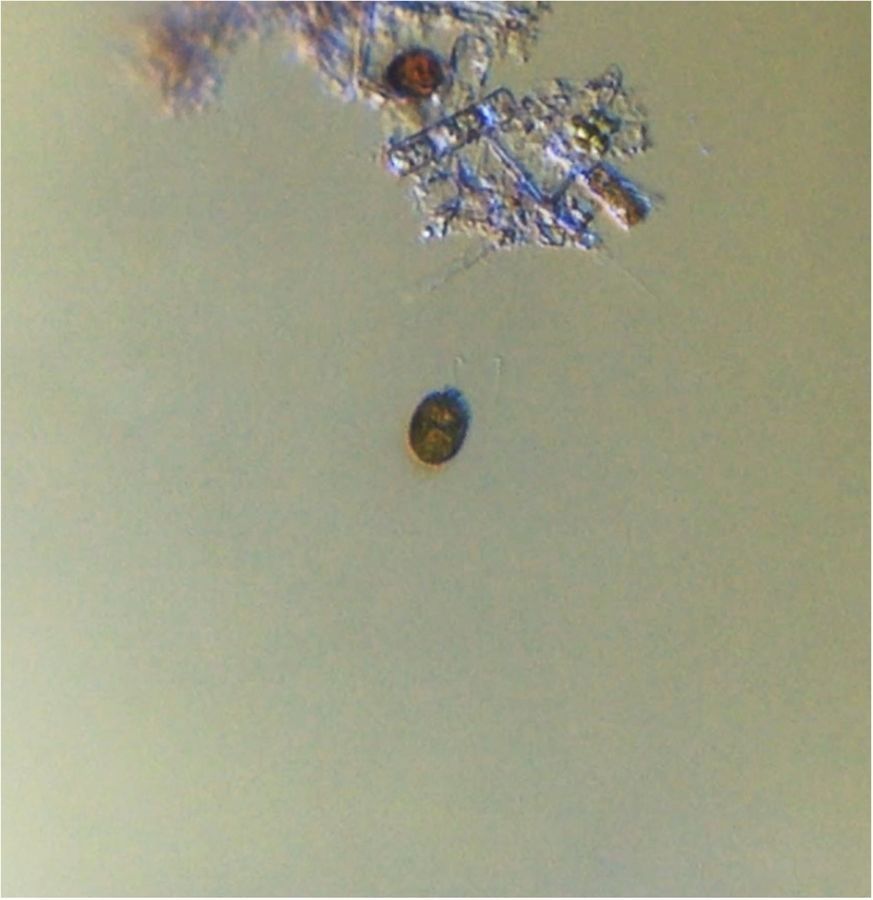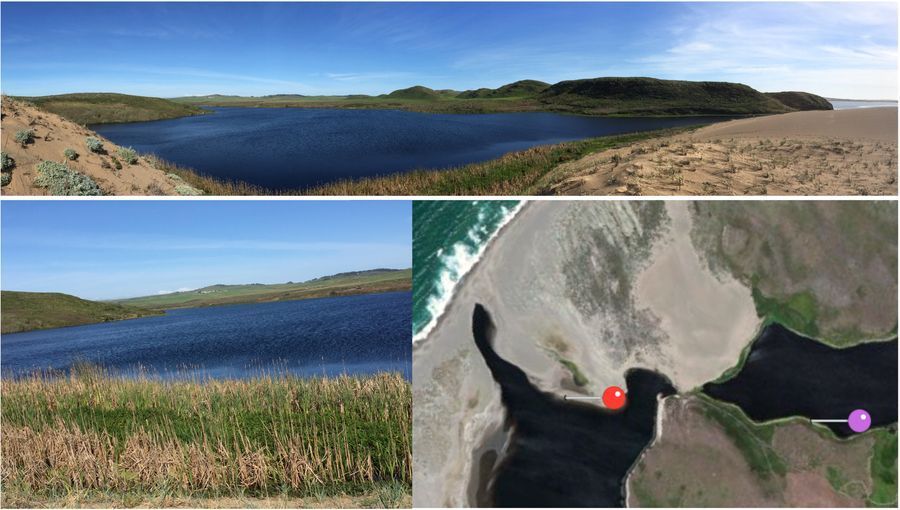Swimming dynamics of a mono-flagellated algae – “cow boy algae”
 Apr 06, 2015 • 9:26 PM UTC
Apr 06, 2015 • 9:26 PM UTC Unknown Location
Unknown Location 140x Magnification
140x Magnification Microorganisms
Microorganisms
Manu Prakash
I am a faculty at Stanford and run the Prakash Lab at Department of Bioengineering at Stanford University. Foldscope community is at the heart of our Frugal Science movement - and I can not tell you how proud I am of this community and grassroots movement. Find our work here: http://prakashlab.stanford.edu
266posts
1192comments
42locations

Continuing my theme of documenting pond scum with Foldscope; I decided to focus this post on a beautiful algae I discovered in pond water collected from “ Abbotts Lagoon

This was a remarkable ecosystem; with water from the ocean meeting sand dunes as far as eye could see and a saltwater lagoon merging talk grass on the banks of the water. I took a small sample of water and started imaging sitting on the sand dune. I have been cataloging all the life forms I imaged on the same day; this is the start of that journey.
My most delughtful finding is captured in this video. As far as I can tell; this is most likely a Trachelomonas. I looked for a catalog of monoflagellated algae species and finally decided on this based on both the surface coat, pattern of flagella activity (more on that later) and also the exact shape of the base of the flagella.
Here is a 5 minute long video. Make sure you watch the end portion of the video to actually clearly see the flagellar beating. Also; it would be best to make the computer screen into full screen mode (try watching this video on a computer instead of a smartphone screen).
My most delughtful finding is captured in this video. As far as I can tell; this is most likely a Trachelomonas. I looked for a catalog of monoflagellated algae species and finally decided on this based on both the surface coat, pattern of flagella activity (more on that later) and also the exact shape of the base of the flagella.
Here is a 5 minute long video. Make sure you watch the end portion of the video to actually clearly see the flagellar beating. Also; it would be best to make the computer screen into full screen mode (try watching this video on a computer instead of a smartphone screen).
I decided to explore if I could identify this species; so I searched in the algae database for common mono-flagellated species; and most likely this is a “Trachelomonas”.
The algae database puts them as around 300 distinct Trachelomonas species: see here .
Classification:
Empire Eukaryota
Kingdom Protozoa
Phylum Euglenozoa
Class Euglenophyceae
Order Euglenales
Family Euglenaceae
Genus Trachelomonas
The distinguishing factors here were the completely enclosing envelope and a neck region where the flagella meets the base. Reading more, I learned I could have cracked the coat/case which the algae has surrounding it and it would still have surrivived (and grown a new coat) – that is what I will do next. It’s around 25microns in size; and is surrounded by a brittle lorcia (envelope). The single flagella is long (almost 50 microns or more).
But i want you to focus on the “flagellar dance” – the pattern of beat of the flagella. The beat is quiet erratic and currently in my low frame rate movies; it almost looks like a cow boy through Lasso .
Since I imaged this at low frame rate; it probably only looks like Lasso. I will do another set of images that allow me to see the fine nature of the “whip”. In the mean time, enjoy the pattern, specially still frames that truly demonstrate the unique pattern of activity of this flagella. Firstly; I was excited about imaging the flagella with no stains and secondly it turned out the flagella did something I have never seen before (although I have looked at flagellar dynamics of many other organisms).
This would also be a great time to introduce an idea of what patterns of flagellar beating would give rise to swimming at small scale. Firstly, you need to know that swimming (when you are small) is a whole another affair. If you want to experience what you would feel like swimming if you were shrunk to a size of 20 microns (roughly the size of this organism); you would have to jump in a bath of honey or corn syrup. Now try swimming in this goop – you realize that it’s kind of tricky to move. The reason for this can be explained by a spectacular dimensionless parameter – used by fluid mechanicians all the time – called the Reynolds number. It’s simply defined as the ratio of inertial force (same inertia you studied in your Newton’s laws) and viscous forces (a new force; related to loss of energy when you try to stir a fluid – say mixing something in honey). The ratio of these two forces can be written as:
Re =/rho L U/eta where /rho is density of the fluid, L is size scale, U is velocity and /eta is viscosity. Plugging some rough quick estimate values; this number is Re ~ 0.0001 (very small).
Since /eta is constant, and L is small – this number ends up being very small; which implies that viscous forces will dominate and we can almost ignore inertia. For the purpose of swimming, it correlates to the fact that as soon as you stop moving your flagella (or putting energy to move); you stop. So no coasting – something you do all the time while swimming in a pool. The poor guy swimming here has to keep putting energy all the time, to move even a tiny bit.
Second surprise comes from the fact; that when you write down the equations of motion for swimming in a fluid at small scale – they follow what is called a Stokes equation. This has a simple yet profoud influence in how you can move forward. The equation is symmetric with respect to time; implying that the fluid kinematics are time reversible (so no difference if time was moving forward or backward). Logically, this says that only the strokes that are non-reversible and assymetric in nature can break free the constraints of “scallop theorem” and hence only very specific class of swimming strokes will give rise to actual forward (or backward motion) at small scales. Or else, you can just keep bobbing at the same place (forward and backward) with a periodic stroke.
Because of all this, swimming microorganisms have developed a very large creative set of swimming motion using cilia and flagella; and they move around in the fluid at small scale as if they don’t care about all these laws of physics. It is indeed incredibly difficult to design artificial swimmers that could meet the level of “swimming dexterity” shown by microorganisms. But they did have hundreds of millions of years to evolve these strokes.
So enjoy this swimming miracle and wait till I capture the swimming dynamics with my high speed iPhone camera.
cheers
manu
The algae database puts them as around 300 distinct Trachelomonas species: see here .
Classification:
Empire Eukaryota
Kingdom Protozoa
Phylum Euglenozoa
Class Euglenophyceae
Order Euglenales
Family Euglenaceae
Genus Trachelomonas
The distinguishing factors here were the completely enclosing envelope and a neck region where the flagella meets the base. Reading more, I learned I could have cracked the coat/case which the algae has surrounding it and it would still have surrivived (and grown a new coat) – that is what I will do next. It’s around 25microns in size; and is surrounded by a brittle lorcia (envelope). The single flagella is long (almost 50 microns or more).
But i want you to focus on the “flagellar dance” – the pattern of beat of the flagella. The beat is quiet erratic and currently in my low frame rate movies; it almost looks like a cow boy through Lasso .
Since I imaged this at low frame rate; it probably only looks like Lasso. I will do another set of images that allow me to see the fine nature of the “whip”. In the mean time, enjoy the pattern, specially still frames that truly demonstrate the unique pattern of activity of this flagella. Firstly; I was excited about imaging the flagella with no stains and secondly it turned out the flagella did something I have never seen before (although I have looked at flagellar dynamics of many other organisms).
This would also be a great time to introduce an idea of what patterns of flagellar beating would give rise to swimming at small scale. Firstly, you need to know that swimming (when you are small) is a whole another affair. If you want to experience what you would feel like swimming if you were shrunk to a size of 20 microns (roughly the size of this organism); you would have to jump in a bath of honey or corn syrup. Now try swimming in this goop – you realize that it’s kind of tricky to move. The reason for this can be explained by a spectacular dimensionless parameter – used by fluid mechanicians all the time – called the Reynolds number. It’s simply defined as the ratio of inertial force (same inertia you studied in your Newton’s laws) and viscous forces (a new force; related to loss of energy when you try to stir a fluid – say mixing something in honey). The ratio of these two forces can be written as:
Re =/rho L U/eta where /rho is density of the fluid, L is size scale, U is velocity and /eta is viscosity. Plugging some rough quick estimate values; this number is Re ~ 0.0001 (very small).
Since /eta is constant, and L is small – this number ends up being very small; which implies that viscous forces will dominate and we can almost ignore inertia. For the purpose of swimming, it correlates to the fact that as soon as you stop moving your flagella (or putting energy to move); you stop. So no coasting – something you do all the time while swimming in a pool. The poor guy swimming here has to keep putting energy all the time, to move even a tiny bit.
Second surprise comes from the fact; that when you write down the equations of motion for swimming in a fluid at small scale – they follow what is called a Stokes equation. This has a simple yet profoud influence in how you can move forward. The equation is symmetric with respect to time; implying that the fluid kinematics are time reversible (so no difference if time was moving forward or backward). Logically, this says that only the strokes that are non-reversible and assymetric in nature can break free the constraints of “scallop theorem” and hence only very specific class of swimming strokes will give rise to actual forward (or backward motion) at small scales. Or else, you can just keep bobbing at the same place (forward and backward) with a periodic stroke.
Because of all this, swimming microorganisms have developed a very large creative set of swimming motion using cilia and flagella; and they move around in the fluid at small scale as if they don’t care about all these laws of physics. It is indeed incredibly difficult to design artificial swimmers that could meet the level of “swimming dexterity” shown by microorganisms. But they did have hundreds of millions of years to evolve these strokes.
So enjoy this swimming miracle and wait till I capture the swimming dynamics with my high speed iPhone camera.
cheers
manu
Sign in to commentNobody has commented yet... Share your thoughts with the author and start the discussion!

 0 Applause
0 Applause 0 Comments
0 Comments
















